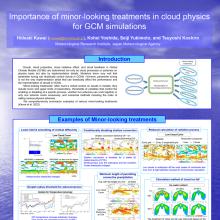Importance of minor-looking treatments in cloud physics for GCM simulations
Hideaki
Kawai
Meteorological Research Institute
Poster
Modelers know very well that parameter tuning of cloud physics can drastically control the performance and the simulation results of global climate models. However, parameter tuning is not the only implementation detail of cloud physics that can drastically affect model performance and the representation of various phenomena in models. For example, lower limits (sometimes upper limits) of parameters often control the model performance critically. Thresholds of variables that control the enabling or disabling of a specific process sometimes exert a large influence on the performance. In addition, numerics, vertical resolution, and timesteps affect significantly the results. The importance of these treatments is often overlooked and not discussed in the literature. However, the impacts of such minor-looking treatments in cloud physics are often even much larger than introducing advanced parameterizations based on theory or observation. We would like to show a number of examples of various minor-looking treatments that can considerably affect model performance and the simulation results (Kawai et al. 2022, JAMES). In addition, we discuss whether observations can reduce uncertainty related to such minor-looking treatments in cloud physics in GCMs.

Kawai-Hideaki-poster.pdf
(1.86 MB)
Meeting homepage
